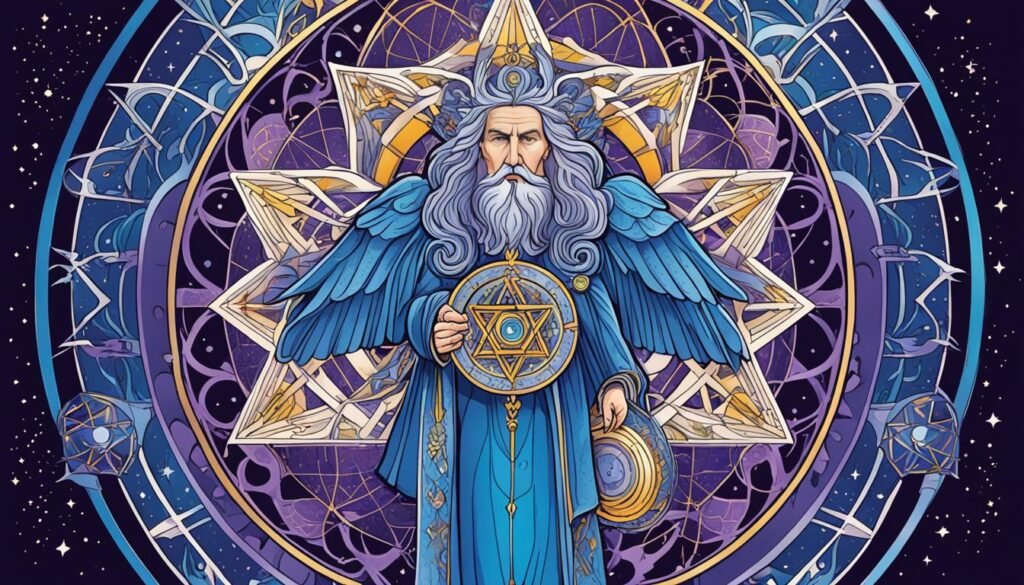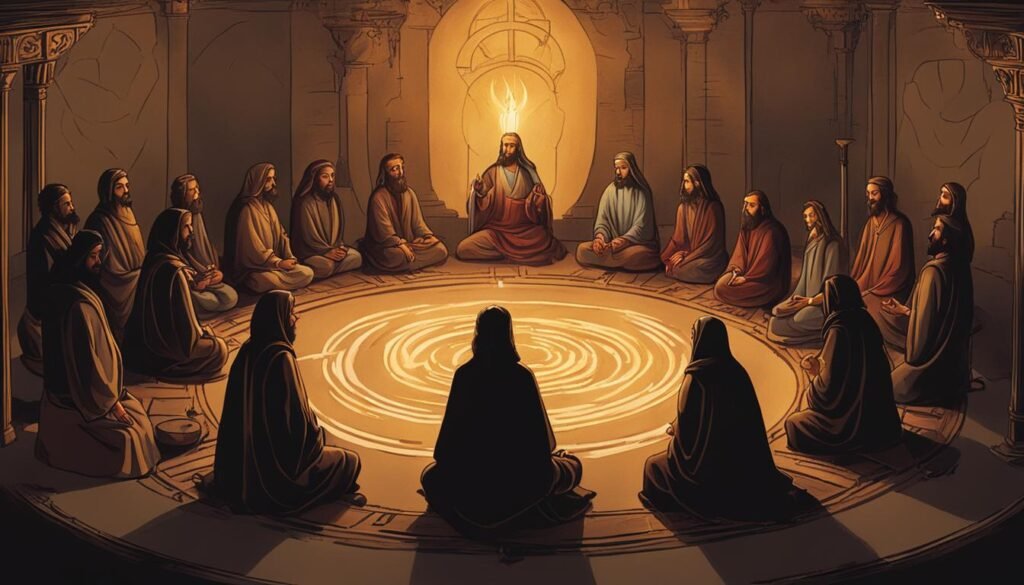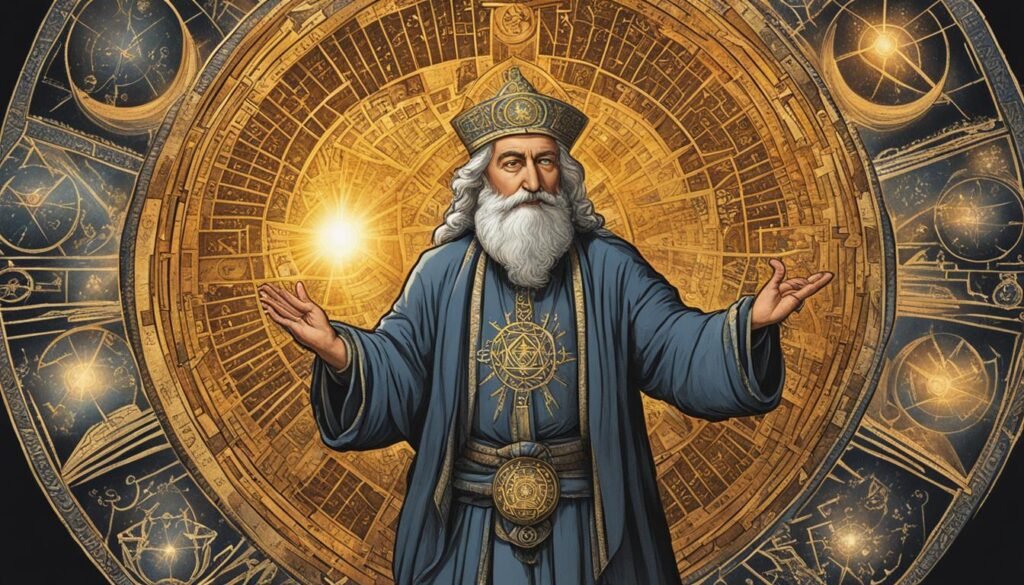When exploring the mystical traditions within Judaism, the question arises: Was Jesus a Kabbalist? Kabbalah, the Jewish mystical tradition, offers a rich tapestry of esoteric teachings and metaphysical concepts. However, while Jesus was a spiritual teacher and mystic, there is no evidence to suggest that he practiced or espoused the detailed metaphysical system of Kabbalah.
Jesus did not teach about the sefirot, the vessels through which the divine is revealed in Kabbalistic thought, nor did he speak about the parallel between human nature and the sefirotic structure. His teachings focused on apocalyptic eschatology, the fall of man, and the need for repentance. Jesus emphasized his role as the Savior of the world and that salvation comes through him alone.
In this article, we will examine the question of whether Jesus was a Kabbalist, explore the influence of Kabbalah on Jewish sages, and delve into the emergence of Christian Kabbalah during the Renaissance.
Key Takeaways:
- Jesus did not teach the detailed metaphysical system of Kabbalah.
- His teachings focused on apocalyptic eschatology and the need for repentance.
- Some Jewish sages have found connections between Kabbalah and the New Testament.
- Christian Kabbalah emerged in the Renaissance, seeking to integrate Kabbalistic ideas into Christian theology.
- Jesus’ mystic teachings used parables and metaphors to convey spiritual truth.
Jesus as a Mystic Teacher
Jesus, the revered spiritual figure, was not just a teacher but also a mystic who used parables and metaphors to convey profound spiritual truths. His teachings are often veiled in symbolic language, inviting his followers to use their intuition and inner wisdom to discern the deeper meanings. Through his metaphoric expressions, Jesus sought to illuminate the nature of the divine and the pathway to spiritual awakening.
“I am the Door; if anyone enters through Me, he will be saved…” – John 10:9
One of the ways Jesus conveyed his teachings was through the use of parables. These short stories, laden with symbolic meaning, enabled him to communicate complex spiritual concepts in a relatable and memorable way. By engaging his listeners’ imaginations, Jesus guided them towards a deeper understanding of the mysteries of the kingdom of God.
For instance, Jesus described himself as “the Bread of Life” and “Living Water,” metaphors that transcend their literal interpretations. In these statements, Jesus alluded to the spiritual sustenance and eternal life accessible through a profound connection with him. The metaphorical language employed by Jesus invited contemplation and reflection, allowing individuals to explore the depths of their own faith.
Jesus also referred to himself as the “Good Shepherd” and the “Light of the World.” Through these symbolic references, he conveyed his role as a guide and a source of divine illumination. Just as a shepherd cares for and protects his flock, Jesus offered his followers love, guidance, and spiritual nurturing. Likewise, as the “Light of the World,” Jesus illuminated the path of righteousness and truth, leading others out of spiritual darkness.
Jesus declared, “I am the way and the truth and the life” (John 14:6), emphasizing the importance of recognizing his divine connection. He taught that the kingdom of God is not external but within each person, highlighting the inherent spiritual potential that can be realized through faith and inner transformation.
The Deeper Meaning of Jesus’ Teachings
While Jesus’ parables and metaphors were accessible to all, their true depth and significance were graspable only to those who approached his teachings with an open heart and a willingness to explore beyond surface-level understanding. The symbolic language employed by Jesus allowed his followers to engage in analogical reasoning and uncover the profound truths concealed within his words.
By conveying spiritual truths through parables and metaphors, Jesus communicated with depth, inviting his listeners to participate actively in the process of understanding. His words were not mere intellectual exercises but pathways to divine revelation. When Jesus claimed to be one with the Father, he revealed his profound connection to God and affirmed his divine nature, encouraging his followers to seek the same unity within themselves.
In summary, Jesus, a true mystic, spoke in metaphors and parables to convey spiritual truth and guide his followers towards deeper understanding. These symbolic teachings illuminated the nature of the divine and our innate connection with God. The mystic teachings of Jesus continue to inspire and illuminate the spiritual journeys of countless individuals.
Kabbalah’s Influence on Jewish Sages
Some Jewish sages have discovered fascinating connections between Kabbalah and the New Testament, delving into the depths of mystical wisdom. In the 17th century, Rabbi Aharon ben Moshe Ha-Kohen of Krakow, after extensive study of Kabbalah, became a believer in Yeshua (Jesus). His exploration led him to identify numerous parallels between the New Testament and the Zohar, which serves as the core text of Jewish mysticism.
Other Jewish believers in Yeshua, such as Yochannan Rittangel and Feivel Levertoff, also recognized intriguing links between Kabbalah and the New Testament. Their deep understanding of Kabbalah allowed them to draw important connections between the two sacred texts. It is worth noting that these Jewish sages possessed a comprehensive knowledge of Kabbalah before making these significant observations.
“The Zohar, with its mystical teachings, unveils passages that shed light on the significance of Jesus.”
– Yochannan Rittangel
These Jewish sages’ examination of Kabbalah in relation to the New Testament opens an intriguing dimension of understanding. By delving into the depths of the Zohar and uncovering hidden wisdom, they shed light on the profound revelations that connect these spiritual traditions.
| Jewish Sage | Time Period | Significance |
|---|---|---|
| Rabbi Aharon ben Moshe Ha-Kohen | 17th Century | Recognized parallels between the New Testament and the Zohar |
| Yochannan Rittangel | 17th Century | Found connections between Kabbalah and the teachings of Jesus |
| Feivel Levertoff | 20th Century | Explored links between Kabbalah and the New Testament |
The research and insights of these Jewish sages offer a unique perspective on the interplay between Kabbalah and the New Testament. By recognizing the parallels and shared wisdom, they bridge the gap between two profound spiritual traditions.
The Compound Unity of God in Kabbalah
One of the key teachings of Kabbalah is the idea that God is a compound unity. The Sefirot, which are attributes of God, are seen as vessels or spheres through which the infinite, transcendent Ein Sof is revealed. They are one with the Creator but also serve as the means through which God communicates with creation. The Sefirot are organized into three “pillars,” and expressions of multiplicitous unity are common in Kabbalistic literature. This understanding of God’s unity is similar to the concept of the Trinity in Christianity.
By viewing God as a compound unity, Kabbalah presents a complex and nuanced understanding of the divine. The Sefirot, often depicted as a hierarchical system of divine emanations, serve as channels through which God’s energy flows into the world. They represent different aspects of God’s nature, including attributes such as love, justice, wisdom, and mercy.
“In Kabbalah, God’s unity is understood as a multifaceted and interconnected reality. The Sefirot, acting as intermediaries between God and creation, reveal the diverse aspects of the divine nature.”
To illustrate the concept of God’s unity, Kabbalistic teachings often employ metaphors and symbols. The Tree of Life, a well-known diagram used in Kabbalah, visually represents the interconnectedness of the Sefirot and their relationship to God. The image below provides a visual representation of the interconnectedness of the Sefirot, highlighting their role in revealing different aspects of God’s unity:
The Interconnectedness of the Sefirot
| Sefirot | Meaning | Attributes |
|---|---|---|
| Keter | Crown | Divine will, limitless light, pure potential |
| Chokhmah | Wisdom | Creative insight, intuitive illumination |
| Binah | Understanding | Discernment, analysis, comprehension |
| Chesed | Loving-kindness | Mercy, compassion, generosity |
| Gevurah | Severity | Justice, strength, self-restraint |
| Tiferet | Beauty | Harmony, balance, integration |
| Netzach | Eternity | Endurance, victory, inspiration |
| Hod | Glory | Splendor, gratitude, surrender |
| Yesod | Foundation | Connection, bonding, stability |
| Malkhut | Sovereignty | Divine presence, manifestation in the physical world |
The interconnectedness of the Sefirot reflects the unity within God while highlighting the diversity of divine attributes. Each Sefirah contributes to the harmonious functioning of the whole divine system, with the ultimate goal of enabling God’s presence to manifest in the material world.
The concept of the compound unity of God in Kabbalah invites contemplation on the interconnectedness and interdependence of all aspects of creation. It encourages individuals to seek unity within themselves and recognize the unity between the physical and spiritual realms.
Kabbalah’s Concept of the Metatron
In Kabbalah, the Shekhinah is believed to be the abode of God’s glory, capable of incarnating in anthropomorphic form. Among these manifestations is the Metatron, known as “the Youth,” “the Angel of the Glory,” and “the body of the Shekhinah.” The Metatron is regarded as a divine figure who serves and ministers to the Shekhinah in the heavenly Sanctuary.
Some Christian Kabbalists have drawn intriguing parallels between the Metatron and Jesus, as both are perceived as embodiments of God in human form.

| Metatron | Jesus |
|---|---|
| Known as “the Youth” | Referred to as “Son of Man” |
| Ministers to the Shekhinah | Embodies God’s presence on Earth |
| Associated with the heavenly Sanctuary | Brings salvation and redemption to mankind |
Comparing Metatron and Jesus
- Both Metatron and Jesus are understood as divine manifestations.
- They are believed to have significant roles in connecting heaven and earth.
- Metatron and Jesus convey the presence and glory of God to humanity.
- Both figures are central to mystical and spiritual traditions.
“The concept of the Metatron and its parallels to Jesus highlight the fascinating intersections between Kabbalah and Christian beliefs.”
Christian Kabbalah in the Renaissance
The Renaissance period marked a significant turning point in the exploration of mystical ideas, with scholars delving into the mystical aspects of Jewish Kabbalah from a Christian perspective. Among the key figures who played a pivotal role in promoting Christian Kabbalah were Giovanni Pico della Mirandola and Johann Reuchlin. These scholars embarked on a journey to synthesize various philosophical and mystical traditions, which included Platonism, Neoplatonism, Aristotelianism, Hermeticism, and Kabbalah. Their objective was to find common ground between Christianity and Jewish mysticism and, furthermore, to seamlessly integrate Kabbalistic concepts into Christian theology.
Giovanni Pico della Mirandola, an Italian Renaissance philosopher, was notable for his work “900 Theses” and “Oration on the Dignity of Man,” both of which examined the interconnectedness of different mystical traditions, including Kabbalah. Pico believed that all spiritual paths ultimately led to the same truths, highlighting the syncretistic nature of Christian Kabbalah.
Johann Reuchlin, a German humanist and scholar, dedicated significant effort to the study of Kabbalah. His influential work, De Verbo Mirifico (On the Wonderful Word), explored the mystical teachings of the Hebrew language and delved into the mystical interpretations of the Kabbalistic tradition. Reuchlin’s work paved the way for a broader understanding and acceptance of Kabbalistic concepts within Christian circles.
These Christian Kabbalists sought to harmonize various mystical and philosophical traditions, recognizing the potential for cross-pollination between different mystical paths. By integrating Kabbalah into Christian theology, they fostered a deeper appreciation for the mystical aspects of spirituality, emphasizing the interconnectedness and universality of mystical experiences across religious traditions.
| Key Figures | Major Works |
|---|---|
| Giovanni Pico della Mirandola | 900 Theses Oration on the Dignity of Man |
| Johann Reuchlin | De Verbo Mirifico |
Through their work, these Christian scholars expanded the intellectual discourse of the Renaissance, bringing together diverse mystical traditions under the umbrella of Christian Kabbalah. Their syncretistic approach not only enriched Christian theology but also paved the way for a deeper appreciation of the mystical dimensions of religious experiences.
Continued exploration and integration of Kabbalistic ideas during the Renaissance nurtured a profound appreciation for the interconnectedness of spiritual traditions and the universality of mystical experiences.
The Syncretic Approach of Christian Kabbalists
Christian Kabbalists like Pico della Mirandola, Reuchlin, and Paolo Riccio employed a syncretic approach to integrate Kabbalistic ideas into Christian theology. They recognized connections between Kabbalistic concepts and Christian doctrines, such as the Trinity and the divinity of Jesus. By bridging these two mystical traditions, they aimed to engage in theological debates with religious Jews and potentially convert them to Christianity.
These Christian Kabbalists carefully studied the Kabbalistic texts and sought to find common ground between Jewish mysticism and Christian theology. They believed that by demonstrating the compatibility and interconnectedness of these two traditions, they could strengthen their theological arguments and appeal to the religious Jews.
“The convergence of Kabbalah and Christianity allowed Christian Kabbalists to engage in profound theological debates with religious Jews. By presenting Kabbalistic interpretations of Christian doctrines, they aimed to challenge existing beliefs and invite reconsideration.”
One fascinating aspect of Christian Kabbalism is the attempt to read the name of Jesus into the unpronounced name of the Jewish God, the tetragrammaton. Some Christian Kabbalists believed that by finding hidden references to Jesus within Jewish sacred texts, they could demonstrate that Jesus was the fulfillment of Jewish prophecies and the ultimate Messiah.
Theological Persuasion with Christian Kabbalah
This syncretic approach of Christian Kabbalists aimed not only to convert religious Jews but also to enrich Christian theology by incorporating Kabbalistic ideas. By integrating mystical Jewish concepts with their own religious beliefs, these scholars sought to deepen their understanding of Christian doctrines and expand the theological discourse.
Through the syncretic approach, Christian Kabbalists hoped to bridge the gap between Christianity and Judaism, emphasizing shared mystical elements and promoting a harmonious coexistence of the two traditions. While their efforts had varying degrees of success, they left a significant mark in the history of religious syncretism and the exploration of mystical practices.

| Christian Kabbalists | Religious Jews |
|---|---|
| Integrate Kabbalistic ideas into Christian theology | Follow traditional Jewish teachings |
| Seek common ground between mystical traditions | Focus on the preservation of Jewish faith |
| Attempt to convert religious Jews to Christianity | Reject Christian theological concepts |
| Read Jesus into the unpronounced name of God | Respect the sacredness of the tetragrammaton |
To summarize, Christian Kabbalists employed a syncretic approach to intertwine Kabbalistic ideas with Christian theology. Through their theological debates and attempts to find connections between the two traditions, they aimed to engage religious Jews and enhance Christian understanding of mystical concepts. This syncretism has left a lasting legacy in the history of religious discourse and the exploration of mystical practices.
Francesco Giorgi and His Contribution to Christian Kabbalah
Francesco Giorgi, a Venetian Franciscan friar, played a pivotal role in the development of Christian Kabbalah during the 16th century. His renowned work, “De harmonia mundi,” stands as a monumental and intricate book that artfully blends various philosophical and mystical traditions. In this groundbreaking publication, Giorgi masterfully combines Hermeticism, Platonic philosophy, Cabalistic ideas, and the teachings of Marsilio Ficino. His synthesis of these diverse strands of thought greatly influenced the trajectory of Christian Kabbalistic understanding.
The work of Francesco Giorgi exemplifies the spirit of syncretism that characterized the Christian Kabbalistic movement during the Renaissance. By merging elements from different philosophical and mystical traditions, Giorgi sought to illuminate the connections between Christian theology and Kabbalistic teachings. Through his extensive research and visionary approach, Giorgi made significant contributions to the ongoing evolution of Christian Kabbalah.
Balthasar Walther and Christian Kabbalah
Balthasar Walther, a Silesian physician, embarked on a pilgrimage to the Holy Land with the aim of delving into the mystical traditions of Kabbalah and Jewish mysticism. Although he did not adhere to the teachings of Jewish authorities, he leveraged his acquired knowledge to advance Christian theological pursuits. While Walther did not author any significant works in the realm of Christian Kabbalah, his exploration and engagement contributed to the sustained interest of Christian scholars in Jewish mysticism.
Walther’s pilgrimage to the Holy Land served as an opportunity for him to immerse himself in the cultural and spiritual milieu that gave birth to the Christian faith. By gaining exposure to Kabbalistic teachings and Jewish mysticism, he broadened his understanding of religious and mystical traditions beyond the confines of Christian theology.
“The journey to the Holy Land allowed Balthasar Walther to explore the roots of his own faith and engage with the mystical traditions that emanated from Jewish sources. His encounters with Kabbalistic ideas and Jewish mysticism would later inform and inspire his own theological pursuits.”
The Intersection of Christian and Jewish Mystical Traditions
In the Renaissance period, Christian scholars such as Walther sought to bridge the gap between Christianity and Jewish mysticism, leading to the emergence of Christian Kabbalah. Drawing upon his pilgrimage and exposure to Kabbalistic concepts, Walther played a role in fostering a greater understanding of the profound connections between these mystical traditions.
Through his exploration of Jewish mystical teachings, Walther sought to harmonize and integrate Kabbalistic ideas into the framework of Christian theological thought. He aimed to unveil the shared spiritual insights that transcended religious boundaries and pave the way for a syncretic approach to understanding divine mysteries.
A Bridge Between Two Worlds
Balthasar Walther’s engagement with Jewish mysticism was a testament to his curiosity and his willingness to explore different spiritual disciplines. His pilgrimage to the Holy Land marked not only a personal endeavor but also a bridge between the worlds of Christianity and Kabbalah, facilitating a deeper understanding of the mystical foundations that underpin both traditions.
While Walther’s contributions to Christian Kabbalah may not have resulted in significant written works, his dedication to studying Jewish mysticism helped shape and propel the enduring interest in the intersections between Christian and Jewish spiritual thought.
| Contributions of Balthasar Walther to Christian Kabbalah | Impact |
|---|---|
| Exploration of Jewish mystical teachings | Expanded understanding of mystical traditions beyond Christianity |
| Integration of Kabbalistic concepts into Christian theology | Facilitated the emergence of Christian Kabbalah |
| Bridge between Christianity and Kabbalah | Fostered dialogue and cross-pollination of mystical ideas |
Balthasar Walther’s pilgrimage to the Holy Land opened doors to the mystical world of Jewish teachings and, in turn, contributed to the development and ongoing exploration of Christian Kabbalah.

Christian Kabbalah in the Aftermath of the Renaissance
After the 18th century, Christian Kabbalah saw a merging with European occultism, some of which had a religious basis. However, mainstream Christian interest in Christian Kabbalah subsequently declined, and it did not find its place within mainstream Christianity. Despite this, there have been attempts in recent decades to revive Christian Kabbalah, particularly in relation to the alleged Neoplatonism present in the Gospel of John. Nonetheless, widespread acceptance of Christian Kabbalah has yet to be achieved.
Conclusion
In conclusion, it can be stated that Jesus, though not a Kabbalist in the modern sense, incorporated mystical teachings into his message. Jesus used parables and metaphors to convey profound spiritual truths, emphasizing the internal kingdom of God within each person. While Jesus did not explicitly teach about Kabbalistic concepts, some Jewish sages have drawn intriguing parallels between Kabbalah and his teachings.
During the Renaissance, Christian Kabbalah emerged as scholars sought to integrate Kabbalistic ideas into Christian theology. Figures like Pico della Mirandola and Reuchlin found commonalities between Kabbalistic concepts and Christian doctrines, sparking theological debates and attempts at religious syncretism. Although Christian Kabbalah did not become mainstream within Christianity, it has continued to fascinate scholars and has left a lasting impact on the history of religious thought.
While Jesus may not be considered a Kabbalist, his mystical teachings and the intersections found between Kabbalah and his message have generated profound discussions. The study of Christian Kabbalah serves as a testament to the ongoing exploration of spirituality, and the desire to seek connections between different religious traditions.
FAQ
Was Jesus a Kabbalist?
No, Jesus did not teach a detailed metaphysical system or explain the details of Kabbalah. He focused on apocalyptic eschatology and emphasized that he alone was the Savior of the world.
How did Jesus teach as a mystic teacher?
Jesus often used parables and metaphors to convey spiritual truth. He referred to himself as “the Door,” the “Bread of Life,” the “Living Water,” the “Good Shepherd,” and the “Light of the World.” These descriptions were meant to convey deeper spiritual truths.
Did any Jewish sages find connections between Kabbalah and Jesus?
Yes, some Jewish sages, such as Rabbi Aharon ben Moshe Ha-Kohen of Krakow, Yochannan Rittangel, and Feivel Levertoff, found parallels between Kabbalah and the New Testament, particularly in the Zohar, the core text of Jewish mysticism.
What is the concept of the compound unity of God in Kabbalah?
In Kabbalah, the Sefirot, which are attributes of God, are seen as vessels or spheres through which the infinite, transcendent Ein Sof is revealed. This understanding of God’s unity is similar to the concept of the Trinity in Christianity.
How does Kabbalah view the concept of the Metatron?
In Kabbalah, the Metatron is seen as a divine figure who ministers to the Shekhinah, the dwelling or abode of the glory of God, in the heavenly Sanctuary. Some Christian Kabbalists have drawn parallels between the Metatron and Jesus as manifestations of God in human form.
When did Christian Kabbalah emerge?
Christian Kabbalah emerged during the Renaissance as scholars began to explore the mystical aspects of Jewish Kabbalah from a Christian perspective.
What was the syncretic approach of Christian Kabbalists?
Christian Kabbalists, such as Giovanni Pico della Mirandola, Johann Reuchlin, and Paolo Riccio, integrated Kabbalistic ideas into Christian theology by finding connections between Kabbalistic concepts and Christian doctrines like the Trinity and the divinity of Jesus.
Who was Francesco Giorgi and how did he contribute to Christian Kabbalah?
Francesco Giorgi, a Venetian Franciscan friar, synthesized various mystical and philosophical traditions, including Kabbalah, into his work “De harmonia mundi,” contributing to the development of Christian Kabbalistic thought.
How did Balthasar Walther contribute to Christian Kabbalah?
Balthasar Walther, a Silesian physician, used his knowledge of Kabbalah and Jewish mysticism to further Christian theological pursuits, although he did not follow the teachings of Jewish authorities. He contributed to the continuation of Christian interest in Jewish mysticism.
What happened to Christian Kabbalah after the Renaissance?
After the 18th century, Christian Kabbalah became blended with European occultism, but mainstream Christian interest in it diminished. There have been some recent attempts to revive Christian Kabbalah, but it has not gained widespread acceptance.
Source Links
- https://hebrew4christians.com/Articles/kabbalah/Jesus_Kabbalah/jesus_kabbalah.html
- https://jewsforjesus.org/learn/jesus-and-the-mysteries-of-kabbalah/
- https://en.wikipedia.org/wiki/Christian_Kabbalah

I’m Benjamin, a passionate spiritual seeker and creator of Verses and Prayers. Alongside my girlfriend Emma and our pet lizard Mulle, I cherish family life, enjoy exploring new places, and am deeply involved in my church community. My love for reading and singing biblical verses inspires every aspect of my journey.

